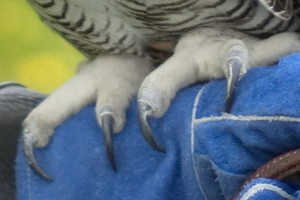 For the January DOC hike we went out onto the Takach property in search of a Great Horned Owl’s nest. (In February the owls are in the nest and will protect their nesting sites aggressively.) The hike leader had found an area where there were promising signs of an owl’s nest. Owl droppings on an old snag used for a lookout were evident as were droppings on a large hemlock with a nest at the top. Feathers were also found at the bottom of the trees. Unfortunately, it snowed the day after finding the site so the group was unable to reach the site due to hazardous footing on a very steep hill. We went looking elsewhere without success. We did create a nesting site by using white paint for the droppings; on the ground, on a snag (dead tree – the lookout) and another tree close by with a nest in it. Scattered pellets and various feathers around the trees put on the final touch.
For the January DOC hike we went out onto the Takach property in search of a Great Horned Owl’s nest. (In February the owls are in the nest and will protect their nesting sites aggressively.) The hike leader had found an area where there were promising signs of an owl’s nest. Owl droppings on an old snag used for a lookout were evident as were droppings on a large hemlock with a nest at the top. Feathers were also found at the bottom of the trees. Unfortunately, it snowed the day after finding the site so the group was unable to reach the site due to hazardous footing on a very steep hill. We went looking elsewhere without success. We did create a nesting site by using white paint for the droppings; on the ground, on a snag (dead tree – the lookout) and another tree close by with a nest in it. Scattered pellets and various feathers around the trees put on the final touch.
All was not lost, we learned about the great owl and had the opportunity to dissect owl pellets at the Takach’s. Moles and voles seemed to be the prevalent prey ingested by the owls. Surprisingly, we found a bird skull and a snake skull, and yes, in answer to everyone’s question and observation of the skull, snakes do have tiny little teeth to help ingest prey.
Great Horned Owls will nest in February, and mate in late November to early January. They do not reuse nests and do not make their own nest but will add feathers and down to squirrel, crow, and hawk nests or a hollow stump. In February the young are hatched. In 6 to 8 weeks the young will come out of the nest and perch among the branches. At 9 to 10 weeks they take flight. Great Horned Owls mate for life but will stay with each other only during nesting. The male will feed the female while she incubates, and both will take turns feeding their young.
The Great Horned Owl is virtually a crepuscular killing machine. (Crepuscular meaning it is most active at dusk and dawn.) Its body is designed to catch prey. That is why it is often called the Winged Tiger. Other names for it are the Hoot Owl, Flying Tiger, and the Cat Owl because of its catlike features.
An owl’s eyes have many rods which pick up light. They see in black and white and see very clearly in the dark. The eyeball is cylinder shaped with no muscles, so the owl must turn its head to see around it. There are 14 vertebrae which allow for a 270 degree rotation of the head. There is a nictating membrane on the eye which allows the owl to blink.
 Talons are what the owl uses to grasp its prey. They are not called claws, because claws shed and retract and talons wear down and do not retract. An owl can grasp with up to 70lbs of pressure and often snap the backs of prey with their 4 talons. When in flight, three talons are held in front with one in the back. Upon perching the outside talon will rotate back so the owl perches with 2 front and 2 back.
Talons are what the owl uses to grasp its prey. They are not called claws, because claws shed and retract and talons wear down and do not retract. An owl can grasp with up to 70lbs of pressure and often snap the backs of prey with their 4 talons. When in flight, three talons are held in front with one in the back. Upon perching the outside talon will rotate back so the owl perches with 2 front and 2 back.
The Great Horned Owl has asymmetrical ear openings which allows for triangulation of sound. In another words, an owl can pinpoint the smallest sound in its exact location. It can hear mice under the snow. The ear holes are located below large facial disks which direct the sound to the ear holes. The tufts on the owl’s head are not the ears but feathers which are used to indicate mood. If the tufts are down look out!
The Great Horned Owl is also often referred to as the silent killer. It is usually 99 percent accurate when pursuing prey. The feathers have a comb like edge which allows for complete silent flight. It is a slow, stealthy hunter in flight and will also hunt on the ground.
Great Horned Owls will eat rodents, birds, other raptors, small dogs and cats, porcupines, skunks, etc. It has no sense of smell, like all raptors, and is the chief predator of the skunk. Owls swallow their prey whole, but will tear apart prey which is too large. Bones, feathers, and fur go into a bell shaped pouch on the esophagus, while digestible parts go to the stomach. When the pouch becomes full the owl will regurgitate the contents in an oblong pellet. When dissected the pellet allows you to see what the owl ate.
How do you find a Great Horned Owl? Follow the steps below:
- Search the woods for pellets, owl droppings, different kinds of feathers scattered around a tree base.
- Listen for the call, “Hoo, hoo – hoo, hoo”.
- Listen for crows. Great Horned Owls are mortal enemies of crows. Crows will gather in large flocks called a “Murder of Crows” and will hassle an owl and may kill it if it takes flight.
- Watch while driving at night on country roads. You might not get a good look at them, but you will get a good idea of their size, which can be up to 2 feet long with a wingspan of almost 5 feet.
- Smell a skunk? It could be an owl kill.
Now that you know so much about owls get out in the woods and start looking. When the parents tolerate your presence, it can be a great experience to watch the young grow.


![highres_324689032[1]](https://duncannonatc.org/wp-content/uploads/2014/02/highres_3246890321-300x228.jpg)

Hope to make March 3 rd Saturday hike.